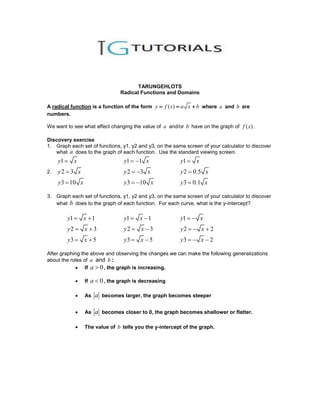
Radical functions
- 1. TARUNGEHLOTS Radical Functions and Domains A radical function is a function of the form y f ( x) a x b where a and b are numbers. We want to see what affect changing the value of a and/or b have on the graph of f ( x) . Discovery exercise 1. Graph each set of functions, y1, y2 and y3, on the same screen of your calculator to discover what a does to the graph of each function. Use the standard viewing screen. y1 x y1 1 x y1 x 2. y2 3 x y 2 3 x y 2 0.5 x y3 10 x y3 10 x y3 0.1 x 3. Graph each set of functions, y1, y2 and y3, on the same screen of your calculator to discover what b does to the graph of each function. For each curve, what is the y-intercept? y1 x 1 y1 x 1 y1 x y2 x 3 y2 x 3 y2 x 2 y3 x 5 y3 x 5 y3 x 2 After graphing the above and observing the changes we can make the following generalizations about the roles of a and b : If a 0 , the graph is increasing. If a 0 , the graph is decreasing As a becomes larger, the graph becomes steeper As a becomes closer to 0, the graph becomes shallower or flatter. The value of b tells you the y-intercept of the graph.
- 2. Example: 1. Sketch y 2 x 4 We begin by noticing that the value of b is 4, so the y-intercept is (0,4). We can now use this to make a table of values. We choose perfect squares for our x-values, because it makes our function easier to evaluate. We then substitute each x-value into our function to obtain the corresponding y-value. x y 0 4 1 2 4 0 9 -2 We now plot each point and connect the points with a smooth curve. Notice that the graph begins at the point (0,4) and decreases from there. This is consistent with our observations made in the discovery exercise. We now want to determine the domain and range of this function. We notice that the smallest x- value reflected in the graph is 0, and that the graph continues for values of x larger than 0. The domain of our graph is thus x 0 . The graph has a largest y-value of 4, and decreases from that point, so the range is y 4 . In general: the domain of y f ( x) a x b is x 0 the range of y f ( x) a x b is: y b if f ( x) is increasing y b if f ( x) is decreasing Finding domains of other radical functions: Recall that the domain of y f ( X ) a X b is X 0 . This makes sense, since we know that only the square root of a non-negative number is defined over the real numbers. We can apply this principal to find the domain of radical functions for which the radicand is not x.
- 3. Examples: 1. Find the domain of y f ( x) x 3 The expression inside the square root sign is x 3 and we know that this must be non- negative. Thus we can write: x 3 0 We now solve for x by subtracting 3 from both sides: x 3 The domain is: x 3 2. Find the domain of y f ( x) 2 x 1 The expression inside the square root sign is 2 x 1 , so we can write: 2x 1 0 Again we solve for x: 2x 1 0 2x 1 x 1 2 0.5 The domain is x 0.5
